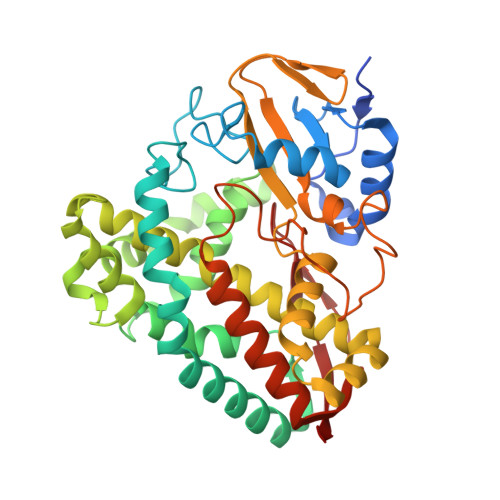Enabling Aromatic Hydroxylation in a Cytochrome P450 Monooxygenase Enzyme through Protein Engineering.
Coleman, T., Lee, J.Z.H., Kirk, A.M., Doherty, D.Z., Podgorski, M.N., Pinidiya, D.K., Bruning, J.B., De Voss, J.J., Krenske, E.H., Bell, S.G.(2022) Chemistry 28: e202201895-e202201895
- PubMed: 36043399
- DOI: https://doi.org/10.1002/chem.202201895
- Primary Citation of Related Structures:
7JXB, 7TND, 7TNF, 7TNU, 8D39 - PubMed Abstract:
The cytochrome P450 (CYP) family of heme monooxygenases catalyse the selective oxidation of C-H bonds under ambient conditions. The CYP199A4 enzyme from Rhodopseudomonas palustris catalyses aliphatic oxidation of 4-cyclohexylbenzoic acid but not the aromatic oxidation of 4-phenylbenzoic acid, due to the distinct mechanisms of aliphatic and aromatic oxidation. The aromatic substrates 4-benzyl-, 4-phenoxy- and 4-benzoyl-benzoic acid and methoxy-substituted phenylbenzoic acids were assessed to see if they could achieve an orientation more amenable to aromatic oxidation. CYP199A4 could catalyse the efficient benzylic oxidation of 4-benzylbenzoic acid. The methoxy-substituted phenylbenzoic acids were oxidatively demethylated with low activity. However, no aromatic oxidation was observed with any of these substrates. Crystal structures of CYP199A4 with 4-(3'-methoxyphenyl)benzoic acid demonstrated that the substrate binding mode was like that of 4-phenylbenzoic acid. 4-Phenoxy- and 4-benzoyl-benzoic acid bound with the ether or ketone oxygen atom hydrogen-bonded to the heme aqua ligand. We also investigated whether the substitution of phenylalanine residues in the active site could permit aromatic hydroxylation. Mutagenesis of the F298 residue to a valine did not significantly alter the substrate binding position or enable the aromatic oxidation of 4-phenylbenzoic acid; however the F182L mutant was able to catalyse 4-phenylbenzoic acid oxidation generating 2'-hydroxy-, 3'-hydroxy- and 4'-hydroxy metabolites in a 83 : 9 : 8 ratio, respectively. Molecular dynamics simulations, in which the distance and angle of attack were considered, demonstrated that in the F182L variant, in contrast to the wild-type enzyme, the phenyl ring of 4-phenylbenzoic acid attained a productive geometry for aromatic oxidation to occur.
Organizational Affiliation:
Department of Chemistry, University of Adelaide, Adelaide, SA, 5005, Australia.

















